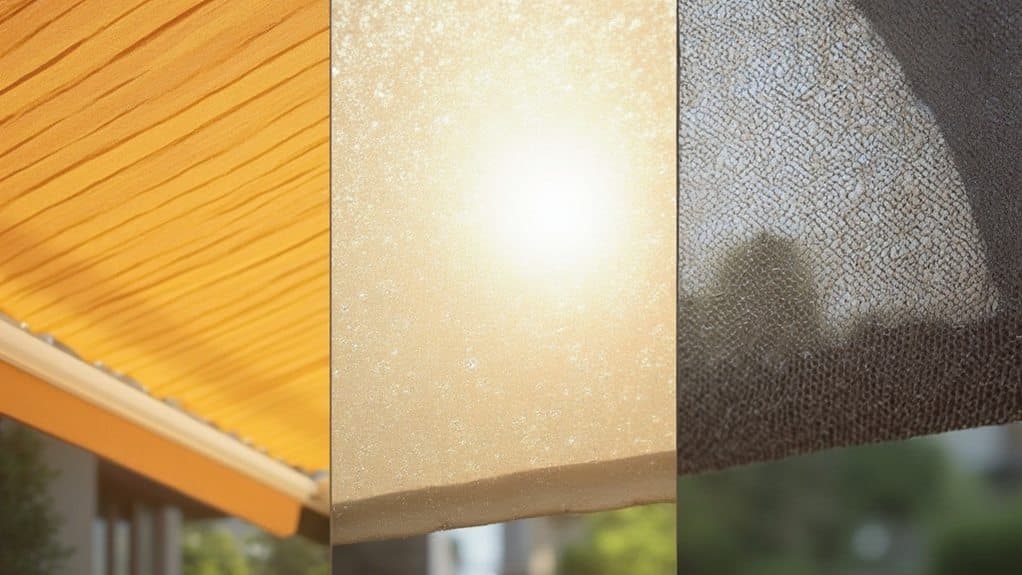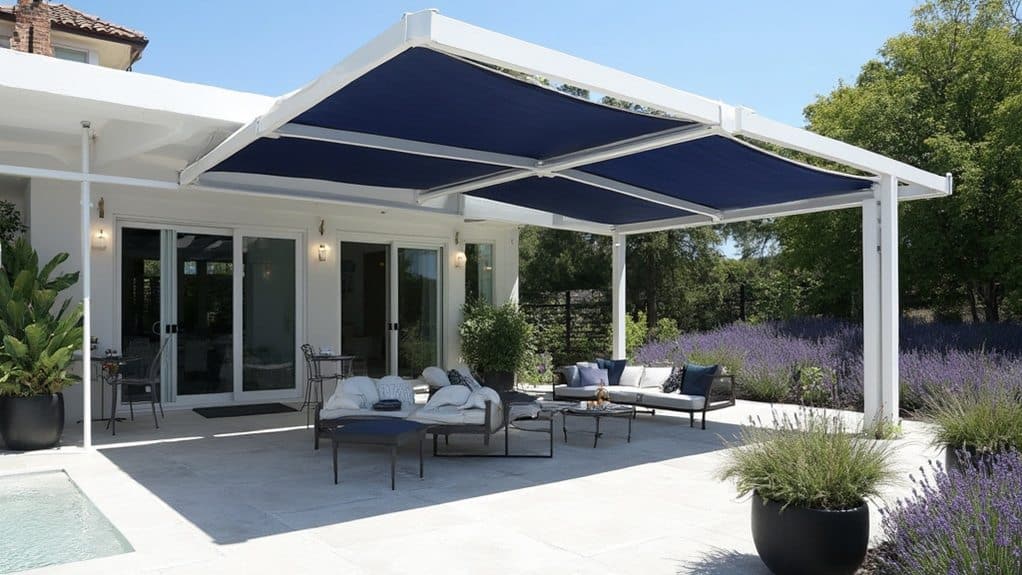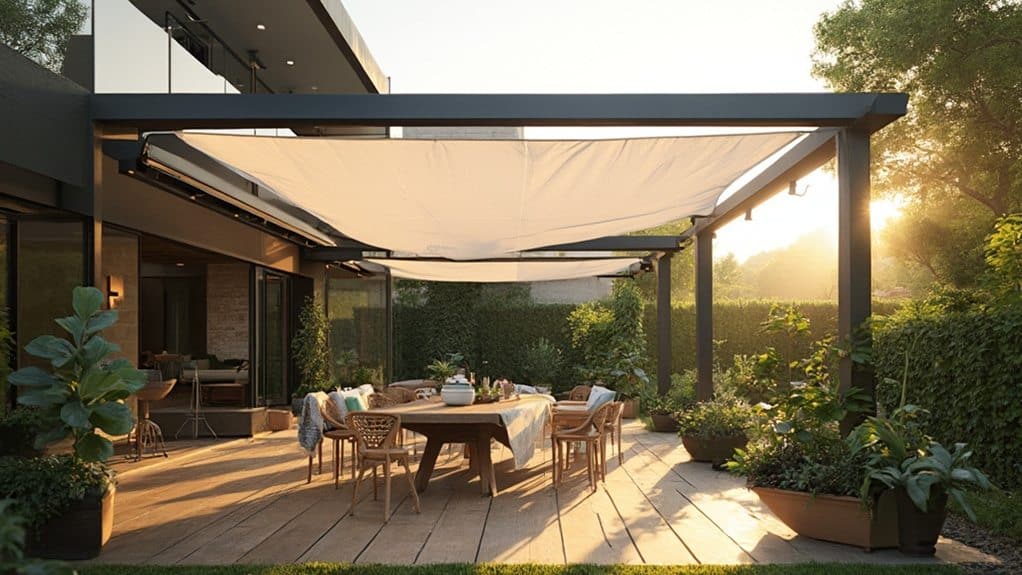Choosing a pergola awning requires careful consideration. Goerres Inc. Pergolas USA offers expert guidance on the key factors: material quality, weather protection and design compatibility. The right awning will enhance your outdoor space and add value to your property. Our specialists can help you choose options that complement your home’s architecture and meet specific climate requirements.
Understanding pergola awning materials

There are three main materials used in the pergola awning market: polyester fabric, acrylic canvas and vinyl. Each material serves a specific purpose in protecting outdoor spaces while providing an alternative to fixed roofing.
Let’s look at polyester fabric first – it’s cost effective and offers basic UV protection and water resistance. Because it’s lightweight, you can install or remove it as required, making seasonal changes easy. Think of it as a basic, functional option that gets the job done.
Acrylic fabric is a step up in quality and performance. Tests show that it blocks UV rays more effectively than polyester and retains its colour even after prolonged exposure to the sun. Its breathable structure prevents moisture build-up and mildew, while it adapts well to changes in temperature. The material’s molecular structure allows air to circulate while keeping water out.
Vinyl is the most durable choice, with proven resistance to environmental stresses. Its synthetic composition creates a completely waterproof barrier and resists tearing under stress. While it may not be as visually appealing as fabric options, vinyl’s practical benefits make it particularly suitable for regions that experience a variety of weather conditions throughout the year.
Weather considerations for your location

When choosing a pergola awning material, your local weather conditions will guide your decision. Understanding your area’s specific weather patterns – including sunlight intensity, rainfall and seasonal variations – will help narrow down the options.
High UV exposure calls for materials that are proven to resist sun damage, such as solution-dyed acrylic or HDPE fabrics. Rainy climates require waterproof materials with built-in drainage systems to prevent water accumulation. Winter weather brings its own challenges: accumulated snow can stress support structures, and freezing temperatures can compromise the structural integrity of certain materials.
Salt air and high winds near the coast quickly corrode standard materials, making marine grade aluminium and special fabric treatments essential. Variable weather zones benefit from retractable systems that adapt to the conditions. Review historical weather data for your location to identify typical patterns and extreme events – this information will have a direct impact on material selection and expected maintenance requirements. Each climate factor will affect both the initial choice and long-term performance of your pergola awning.
Retractable vs Fixed Options

The choice between a retractable and a fixed pergola awning will determine how you use your outdoor space. Each design offers distinct advantages that affect both functionality and long-term satisfaction with your installation.
Retractable systems give you direct control over your surroundings. You can extend the awning when you need shade and roll it back when you want more sunlight. These systems protect the fabric from harsh weather conditions when stored, helping to extend its life. The main trade-off is cost – retractable mechanisms involve more parts and engineering, leading to a higher initial investment and potential maintenance requirements.
Fixed pergola awnings offer structural simplicity and reliability. Manufactured from weatherproof materials and with secure mounting systems, they require minimal maintenance once installed. The simple design reduces both initial costs and long-term maintenance requirements. Permanent coverage means careful planning is essential – you’ll need to consider sun patterns and seasonal changes before installation. With no moving parts, these systems provide consistent protection through their engineered durability.
Size and coverage requirements

Getting your pergola awning measurements right makes all the difference in creating a functional outdoor space. Let’s start by measuring the width, length and height of your existing pergola – we need to note any features or obstructions that may affect where we can install the awning.
The amount of shade you want will guide our sizing decisions. The sun will move across your space differently each season, so think about when you’ll be using the area most. A handy tip: extend the awning 12-18 inches beyond each side of your pergola to block the angled rays that sneak in during the early morning and late afternoon.
Finding the right coverage area is a simple calculation – multiply the length by the width, then take into account any slopes or special features. Leave enough space around doors, windows and vents. The awning should extend just beyond your seating areas to provide adequate shade without overloading the structure. Tests show that oversized awnings catch more wind and can stress the mounting points, while undersized awnings leave gaps in coverage.
Design style and colour choice

The visual appeal of your pergola awning depends on choosing colours and designs that work well with the exterior of your home. You’ll want to consider your home’s architectural features, surface textures and existing colours to ensure the awning enhances the look of your property.
Style options range from traditional to contemporary – you may like classic stripes or prefer a clean, solid colour. While vibrant colours can create focal points, neutral tones adapt well across the seasons and remain stylistically relevant for longer. Each material and finish reacts differently to weathering, with some colours showing UV damage more quickly than others.
Your awning doesn’t have to match the colour palette of your home. Think about colours that create pleasing contrasts while maintaining visual balance. Darker colours naturally absorb more of the sun’s energy, while lighter colours reflect it. This difference has a direct effect on the temperature under your awning throughout the year. The design you choose should balance your style preferences with these functional aspects of solar protection and thermal management.
Installation and maintenance

The performance of your pergola awning depends on correct installation and regular maintenance. Before installation, check that your structure can support the additional load – typically 2-3 pounds per square foot of awning material. Each mounting bracket must be securely fastened with appropriate hardware to prevent accidents. A certified installer can ensure correct installation, reducing the risk of future complications.
Caring for your awning isn’t complicated, but it does require attention. Set aside time each month to check all components: look for loose screws, fabric damage and early signs of corrosion. The fabric should be cleaned each season with mild soap and water – harsh chemicals can damage the fabric’s protective coating. Remove accumulated debris immediately, as organic matter can trap moisture and accelerate deterioration. When wind speeds exceed 20 mph or snow accumulates, retract the awning to protect its mechanisms.
Documentation helps keep track of maintenance requirements. Keep a log of inspections, cleaning dates and any repairs. In regions where winter temperatures regularly drop below freezing or snowfall is common, dismantling and storing the awning indoors preserves its structural integrity and fabric quality. The controlled environment prevents metal fatigue and fabric stretching that occurs with prolonged exposure to severe weather conditions.
Budget and long term value

The installation of a pergola awning is a significant investment that deserves careful budget planning. Your initial analysis should cover the whole cost picture: purchase price, installation labour, ongoing maintenance and any repairs. While premium materials may cost more upfront, their longer life and reduced maintenance requirements often translate into better value over time.
The awning’s contribution to energy efficiency plays a key role in its overall value proposition. Research shows that effective shading can reduce indoor temperatures by 8-15 degrees Fahrenheit, resulting in a measurable reduction in air-conditioning costs. Property data shows that well-designed outdoor spaces, including pergolas, can increase property values by 5-10% when properly maintained.
A detailed cost analysis should cover at least 10 years of ownership. This calculation takes into account the materials’ resistance to UV degradation, local weather conditions and expected maintenance intervals. Warranty details are important – look for comprehensive protection against material defects and environmental damage. By choosing materials suited to your climate and understanding the full maintenance schedule, you’ll be making an investment decision based on hard data, not just initial price.

